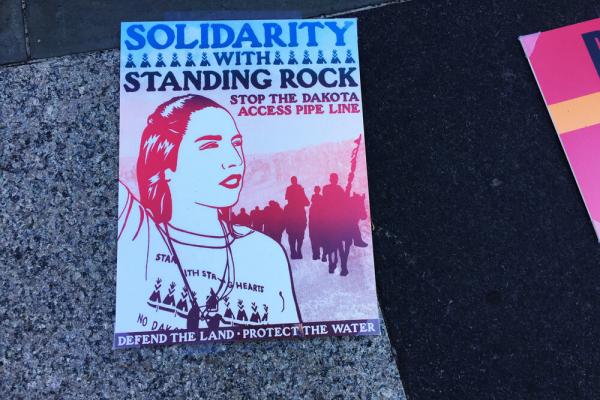On the second Sunday of Advent, I was part of a historic celebration of the power of nonviolent resistance. Here at Standing Rock Sioux Reservation, thousands of voices cried out in America’s wilderness.
Dec. 4 was a beautiful reminder, in the long struggle for justice, that, no matter how long we wait, God hears our cry. And love and justice will win.
A few weeks ago, Chief Arvol Looking Horse issued an invitation to clergy and faith leaders to stand in solidarity with the people of Standing Rock. He said he was hoping maybe 100 would respond. But I joined thousands, in a procession of faith leaders, to gather around the sacred fire at the Oceti Sakowin Camp at Standing Rock.
I knew something special was happening here.
As the entire camp held hands in prayer, we learned that the U.S. Army Corps of Engineers had refused to grant an easement to complete the Dakota Access pipeline, a $3.8 billion project that stretches across four states.
From the beginning, the pipeline has been resisted as a “black snake” that threatens the sacred waters of the Sioux people. And, in recent months, pipeline construction destroyed holy sites.
But Native American tribes, from some 200 nations, came together here to protect their water and resist the Dakota Access Pipeline. On Sunday, they won.
The water protectors here have been attacked by dogs, tear-gassed, hit with rubber bullets, and hosed down with water in below-freezing temperatures. The police have been brutal on the vigilant, nonviolent people protecting their sacred land and water. But they have shown us how people of faith can stand up to broken promises, and corporate greed, in the strength of nonviolent resistance.
It’s great to see how the resistance here was started by young people. Like the students who started the sit-in movement in 1960, 200 Native American young people rode here on horseback in the spring and established a base for resistance. They had the vision and the zeal, but elders and holy men like Chief Looking Horse embraced them, and invited official leadership in Indian Country to support their resistance.
It’s a beautiful example that’s echoed when civil rights veterans stand with Black Lives Matter activists, and clergy go to jail with fast food workers in the Fight for 15.
Our nonviolent struggle is a journey that spans generations.
It’s also deeply rooted in prayer. My brother Richard Twiss helped me, and many Red Letter Christians, overcome the colonial misconception that Jesus is at odds with Native American spirituality. Standing Rock has become an important center for spiritual formation this year, inviting people who want to connect their faith with action to see that we are more than “protesters.” We are “water protectors,” called by our Creator to watch over and care for all the good gifts of creation.
Whatever their religious traditions, the people who stood united in prayer, as the news of victory came in on Dec. 4, witnessed the power of God. We got to stand together and experience the glory of a justice party.
In the Advent readings for Sunday, John the Baptist points us to a voice crying out in the wilderness, “Prepare the way of the Lord.” This snow-covered prairie feels like an unlikely place for a party.
But John knew that what Isaiah had promised is true: “Every valley shall be lifted up, every mountain and hill made low … and the glory of the Lord will be revealed and all people will see it together.”
It’s an honor to be here with the people of Standing Rock. And it’s inspiring to see how they’re showing the world what the revolutionary love of Jesus looks like in 21st-century America.
Got something to say about what you're reading? We value your feedback!

